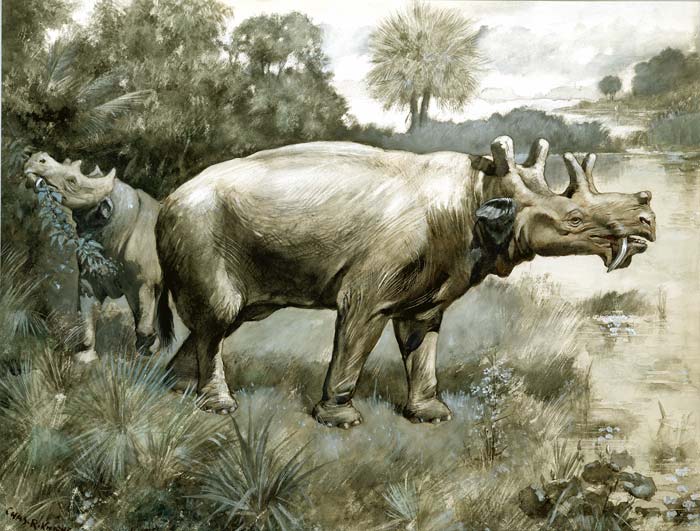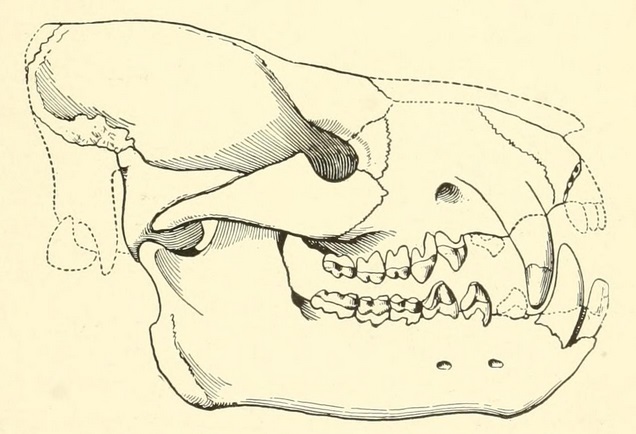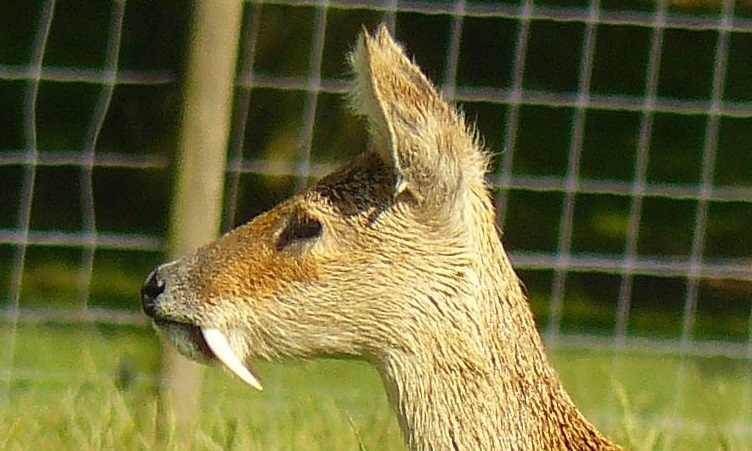|
Uintatherium
''Uintatherium'' ("Beast of the Uinta Mountains") is an extinct genus of herbivorous dinoceratan mammal that lived during the Eocene epoch. Two species are currently recognized: ''U. anceps'' from the United States during the Early to Middle Eocene (50.5-39.7 million years ago) and ''U. insperatus'' of Middle to Late Eocene (48–37 million years ago) China. The first fossils of ''Uintatherium'' were recovered in the Bridger Formation, Fort Bridger Basin, and were initially believed to belong to a new species of Brontotheriidae, brontothere. Despite other generic names being assigned, such as Edward Drinker Cope's ''Loxolophodon'' and Othniel Charles Marsh's ''Tinoceras'', and an assortment of attempts at naming new species, ''Uintatherium anceps'' has since come to encompass all of these. The Phylogenetic tree, phylogeny of ''Uintatherium'' and other dinoceratans has long been debated. Originally, they were assigned to the now-invalid Order (biology), order Amblypoda, which un ... [...More Info...] [...Related Items...] OR: [Wikipedia] [Google] [Baidu] |
Dinocerata
Dinocerata, from Ancient Greek (), "terrible", and (), "horn", or Uintatheria, is an extinct order of large herbivorous hoofed mammals with horns and protuberant canine teeth, known from the Paleocene and Eocene of Asia and North America. With body masses ranging up to they represent some of the earliest known large mammals.Spencer G. Lucas, Robert M. Schoch 19. "Dinocerata" in: Evolution of Tertiary Mammals of North America: Volume 1, Terrestrial Carnivores, Ungulates, and Ungulate like Mammals (1998) Description Uintatheriids are suggested to have been Browsing (herbivory), browsers. Over the course of their evolution, dinoceratans underwent a great increase in body size, from a weight of in the earliest species to a weight of up to in the largest species, co-inciding with the development of fully graviportal limbs with a digitigrade posture. Later members of the order are noted for their distinctive pairs of horns that develop from the maxillary and Parietal bone, parie ... [...More Info...] [...Related Items...] OR: [Wikipedia] [Google] [Baidu] |
Eobasileus
''Eobasileus cornutus'' ("horned dawn-king") was a prehistoric species of Dinocerata, dinocerate mammal. Description With a skull about in length, and standing some tall at the shoulder, with a weight estimated to be around , ''Eobasileus'' was the largest uintathere. It looked much like the related ''Uintatherium''. Like ''Uintatherium'', it had three pairs of blunt Horn (anatomy), horns on its skull, possibly covered with skin like the ossicones of a giraffe. The frontal pair may have been composed of keratin, like the horn(s) of a rhinoceros. ''Eobasileus'' also had a pair of tusks shielded by bony protrusions of the lower jaw. A dispute over ''Eobasileus'' specifically and the uintatheres more generally helped to spark the Bone Wars between Edward Drinker Cope and Othniel Charles Marsh. Cope, Marsh, and Joseph Leidy independently discovered specimens from related species—though Cope and Marsh believed they had each discovered the same species—in the Fort Bridger, Wy ... [...More Info...] [...Related Items...] OR: [Wikipedia] [Google] [Baidu] |
Eocene
The Eocene ( ) is a geological epoch (geology), epoch that lasted from about 56 to 33.9 million years ago (Ma). It is the second epoch of the Paleogene Period (geology), Period in the modern Cenozoic Era (geology), Era. The name ''Eocene'' comes from the Ancient Greek (''Ēṓs'', 'Eos, Dawn') and (''kainós'', "new") and refers to the "dawn" of modern ('new') fauna that appeared during the epoch.See: *Letter from William Whewell to Charles Lyell dated 31 January 1831 in: * From p. 55: "The period next antecedent we shall call Eocene, from ήως, aurora, and χαινος, recens, because the extremely small proportion of living species contained in these strata, indicates what may be considered the first commencement, or ''dawn'', of the existing state of the animate creation." The Eocene spans the time from the end of the Paleocene Epoch to the beginning of the Oligocene Epoch. The start of the Eocene is marked by a brief period in which the concentration of the carbon isoto ... [...More Info...] [...Related Items...] OR: [Wikipedia] [Google] [Baidu] |
Bridger Formation
The Bridger Formation is a Formation (geology), geologic formation in southwestern Wyoming. It preserves fossils dating back to the Bridgerian and Uintan North American land mammal age, stages of the Paleogene Period (geology), Period. The formation was named by American geologist Ferdinand Vandeveer Hayden for Fort Bridger, which had itself been named for mountain man Jim Bridger. The Bridger Wilderness covers much of the Bridger Formation's area. History Before colonization, the lands making up the Bridger Formation had been inhabited by the Crow Nation, Apsáalooke, Bannock people, Bannock, Eastern Shoshone, Arapaho, Hinono'eino, Sioux, Očhéthi Šakówiŋ, Cheyenne, Só'taeo'o, Cheyenne, Tsétsêhéstâhese, and Ute people, Ute nations. European settlers began to settle the area around the Bridger Formation in the 19th century, beginning with the establishment of the Oregon Trail in 1830. Fort Bridger – for which the formation would later be named – was established in 184 ... [...More Info...] [...Related Items...] OR: [Wikipedia] [Google] [Baidu] |
Amblypoda
Amblypoda was a taxonomic hypothesis uniting a group of extinct, herbivorous mammals. They were considered a suborder of the primitive ungulate mammals and have since been shown to represent a polyphyletic group. Characteristics The Amblypoda take their name from their short and stumpy feet, which were furnished with five toes each and supported massive pillar-like limbs. The brain cavity was extremely small and insignificant in comparison to the bodily mass, which was equal to that of the largest rhinoceroses. These animals were descendants of the small ancestral ungulates that retained all the primitive characteristics of the latter, accompanied by a huge increase in body size. The Amblypoda were confined to the Paleocene and Eocene periods and occurred in North America, Asia (especially Mongolia) and Europe. The cheek teeth were short-crowned (brachyodont), with the tubercles more-or-less completely fused into transverse ridges, or cross-crests (lophodont type), and the total nu ... [...More Info...] [...Related Items...] OR: [Wikipedia] [Google] [Baidu] |
Canine Tooth
In mammalian oral anatomy, the canine teeth, also called cuspids, dogteeth, eye teeth, vampire teeth, or fangs, are the relatively long, pointed teeth. In the context of the upper jaw, they are also known as '' fangs''. They can appear more flattened, however, causing them to resemble incisors and leading them to be called ''incisiform''. They developed and are used primarily for firmly holding food in order to tear it apart, and occasionally as weapons. They are often the largest teeth in a mammal's mouth. Individuals of most species that develop them normally have four, two in the upper jaw and two in the lower, separated within each jaw by incisors; humans and dogs are examples. In most species, canines are the anterior-most teeth in the maxillary bone. The four canines in humans are the two upper maxillary canines and the two lower mandibular canines. They are specially prominent in dogs (Canidae), hence the name. Details There are generally four canine teeth: two ... [...More Info...] [...Related Items...] OR: [Wikipedia] [Google] [Baidu] |
Cheek Teeth
Cheek teeth or postcanines comprise the molar and premolar teeth in mammals. Cheek teeth are multicuspidate (having many folds or tubercles). Mammals have multicuspidate molars (three in placentals, four in marsupials, in each jaw quadrant) and premolars situated between canines and molars whose shape and number varies considerably among particular groups. For example, many modern Carnivora possess carnassials, or secodont teeth. This scissor-like pairing of the last upper premolar and first lower molar is adapted for shearing meat. In contrast, the cheek teeth of deer and cattle are selenodont. Viewed from the side, these teeth have a series of triangular cusps or ridges, enabling the ruminants' sideways jaw motions to break down tough vegetable matter. Cheek teeth are sometimes separated from the incisors by a gap called a diastema. Cheek teeth in reptiles are much simpler as compared to mammals. Roles and significance Apart from helping grind the food to properly reduce th ... [...More Info...] [...Related Items...] OR: [Wikipedia] [Google] [Baidu] |
Sexual Dimorphism
Sexual dimorphism is the condition where sexes of the same species exhibit different Morphology (biology), morphological characteristics, including characteristics not directly involved in reproduction. The condition occurs in most dioecy, dioecious species, which consist of most animals and some plants. Differences may include secondary sex characteristics, size, weight, color, markings, or behavioral or cognitive traits. Male-male reproductive competition has evolved a diverse array of sexually dimorphic traits. Aggressive utility traits such as "battle" teeth and blunt heads reinforced as battering rams are used as weapons in aggressive interactions between rivals. Passive displays such as ornamental feathering or song-calling have also evolved mainly through sexual selection. These differences may be subtle or exaggerated and may be subjected to sexual selection and natural selection. The opposite of dimorphism is ''monomorphism'', when both biological sexes are phenotype, ... [...More Info...] [...Related Items...] OR: [Wikipedia] [Google] [Baidu] |
Proboscidea
Proboscidea (; , ) is a taxonomic order of afrotherian mammals containing one living family (Elephantidae) and several extinct families. First described by J. Illiger in 1811, it encompasses the elephants and their close relatives. Three living species of elephant are currently recognised: the African bush elephant, the African forest elephant, and the Asian elephant. Extinct members of Proboscidea include the deinotheres, mastodons, gomphotheres and stegodonts. The family Elephantidae also contains several extinct groups, including mammoths and '' Palaeoloxodon''. Proboscideans include some of the largest known land mammals, with the elephant '' Palaeoloxodon namadicus'' and mastodon ''"Mammut" borsoni'' suggested to have body masses surpassing , rivalling or exceeding paraceratheres (the otherwise largest known land mammals) in size. The largest extant proboscidean is the African bush elephant, with a world record of size of at the shoulder and . In addition to thei ... [...More Info...] [...Related Items...] OR: [Wikipedia] [Google] [Baidu] |
Paleocene–Eocene Thermal Maximum
The Paleocene–Eocene thermal maximum (PETM), alternatively ”Eocene thermal maximum 1 (ETM1)“ and formerly known as the "Initial Eocene" or “Late Paleocene thermal maximum", was a geologically brief time interval characterized by a global average temperature rise and massive input of carbon into the ocean and atmosphere. The event began, now formally codified, at the precise time boundary between the Paleocene and Eocene geological Epoch (geology), epochs. The exact age and duration of the PETM remain uncertain, but it occurred around 55.8 million years ago (Ma) and lasted about 200 thousand years (Ka). The PETM arguably represents our best past analogue for which to understand how global warming and the carbon cycle operate in a greenhouse world. The time interval is marked by a prominent negative excursion in carbon stable isotope () records from around the globe; more specifically, a large decrease in the 13C/Carbon-12, 12C ratio of marine and terrestrial carbon ... [...More Info...] [...Related Items...] OR: [Wikipedia] [Google] [Baidu] |
Rhinoceros
A rhinoceros ( ; ; ; : rhinoceros or rhinoceroses), commonly abbreviated to rhino, is a member of any of the five extant taxon, extant species (or numerous extinct species) of odd-toed ungulates (perissodactyls) in the family (biology), family Rhinocerotidae; it can also refer to a member of any of the extinct species of the superfamily Rhinocerotoidea. Two of the extant species are native to Africa, and three to South Asia, South and Southeast Asia. Rhinoceroses are some of the largest remaining megafauna: all weigh over half a tonne in adulthood. They have a herbivore, herbivorous diet, small brains for mammals of their size, one or two horns, and a thick , protective skin formed from layers of collagen positioned in a crystal structure, lattice structure. They generally eat leafy material, although their ability to ferment food in their colon (anatomy), hindgut allows them to subsist on more fibrous plant matter when necessary. Unlike other perissodactyls, the two African ... [...More Info...] [...Related Items...] OR: [Wikipedia] [Google] [Baidu] |
Birch
A birch is a thin-leaved deciduous hardwood tree of the genus ''Betula'' (), in the family Betulaceae, which also includes alders, hazels, and hornbeams. It is closely related to the beech- oak family Fagaceae. The genus ''Betula'' contains 30 to 60 known taxa of which 11 are on the IUCN 2011 Red List of Threatened Species. They are typically short-lived pioneer species and are widespread in the Northern Hemisphere, particularly in northern areas of temperate climates and in boreal climates. Birch wood is used for a wide range of purposes. Description Birch species are generally small to medium-sized trees or shrubs, mostly of northern temperate and boreal climates. The simple leaves are alternate, singly or doubly serrate, feather-veined, petiolate and stipulate. They often appear in pairs, but these pairs are really borne on spur-like, two-leaved, lateral branchlets. The fruit is a small samara, although the wings may be obscure in some species. They differ from t ... [...More Info...] [...Related Items...] OR: [Wikipedia] [Google] [Baidu] |










